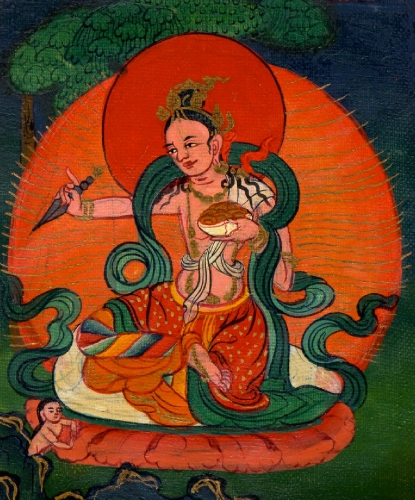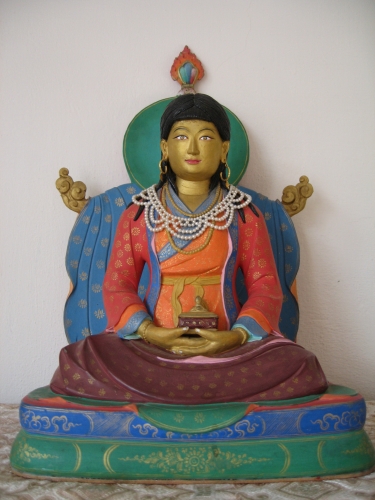Biography and autobiography in Tibet are important sources for both education and inspiration. Tibetans have kept such meticulous records of their teachers that thousands of names are known and discussed in a wide range of biographical material. All these names, all these lives—it can be a little overwhelming. The authors involved in the Treasury of Lives are currently mining the primary sources to provide English-language biographies of every known religious teacher from Tibet and the Himalaya, all of which are organized for easy searching and browsing. Every Tuesday on the Tricycle blog, we will highlight and reflect on important, interesting, eccentric, surprising and beautiful stories found within this rich literary tradition.
Female Buddhist Masters: Chime Tenpai Nyima and Sera Khandro
There have been many significant female masters in Tibetan Buddhism, but their stories are often difficult to find. Women in Tibet have had to struggle to live a religious life, whether that meant to live as a nun or hermit or simply practice at home. The relatively low status of women in Tibet in general meant that their achievements commonly went unnoticed and thus unrecorded in the historical records.

Yet examples abound of women who attained high status in religious circles throughout Tibetan history, from the (possibly) mythological Yeshe Tsogyel in the eighth century to the many female teachers active today. Two biographies on the Treasury of Lives site that illustrate the lives of female masters in Tibetan Buddhism are those of Chime Tenpai Nyima, written by Elisabeth Benard, and Sera Khandro, written by Sarah Jacoby.
Chime Tenpai Nyima was a member of the illustrious Khon family that has led the Sakya tradition since its founding in the eleventh century. Her story is one of rare institutional support for a female master. The Khon family is perhaps unique in Tibetan Buddhism in its continual support and encouragement to its female members to pursue a religious vocation—they are collectively known as the Sakya Jetsumas, or Female Venerables of the Sakya tradition—and today there are several important living female teachers of the Sakya tradition active in the West.
The facts that are known of her life testify to her exalted status within the Sakya tradition. Chime Tenpai Nyima was born in 1756, to a brother of the famous Sachen Kunga Lodro (1729-1783). Kunga Lodro took on his niece as one of his main disciples, transmitting the core Sakya Lamdre and the Vajrayogini teachings as well as many others. With access to teachings she became quite learned, and with support for practice she mastered the traditions. Evidence of her status in the lineage is found in her having been assigned to recite the Vajrayoginī prayers and accompanying offerings for funeral rites of Kunga Lodro. She was a teacher to four Sakya Tridzin, the heads of the tradition: the Thirty-third, Thirty-fourth, Thirty-fifth, and Thirty-sixth; as well as abbots of Ngor Monastery and others.

Where Chime Tenpai Nyima enjoyed family and institutional support, most women in Tibet have not. Sera Khandro (1892-1940), who was born into a prominent family in Lhasa, lost all the privileges of wealth when she ran away from home to escape an unwelcomed engagement and follow the teacher Drime Ozer (1881-1924) and his disciples, who were then in Lhasa on pilgrimage from Golok, Amdo. She returned with the group and lived in dire poverty; not long after they arrived in Golok, Sera Khandro entered what would become a turbulent partnership with Garra Gyelse, with whom she had two children.
Sera Khandro had experienced visions of Vajravarahi beginning at an early age, and exhibited many indications of being a treasure revealer, meaning that she was destined to reveal scripture said to have been concealed by the eighth-century Indian mystic Padmasambhava. Garra Gyelse disapproved of Sera Khandro’s revelations, and under his prohibition she fell ill. Only when she returned to Drime Ozer did her health return, and together they revealed the treasure scriptures for which she is known. Having struggled against family, poverty, and patriarchy her entire life, she emerged as one of the most remarkable teachers of the twentieth century, a teacher to many of the century’s leading Nyingma lamas, including Dudjom Jikdrel Yeshe Dorje (1904-87) and Chadrel Sanggye Dorje (b. 1913).
Other prominent women whose biographies are now on the Treasury of Lives include Machik Labdron (1055-1149) and Ayu Khandro Dorje Peldron (1839-1953).
Related: The Rising Generation of Female Tibetan Buddhist Leaders
Thank you for subscribing to Tricycle! As a nonprofit, we depend on readers like you to keep Buddhist teachings and practices widely available.